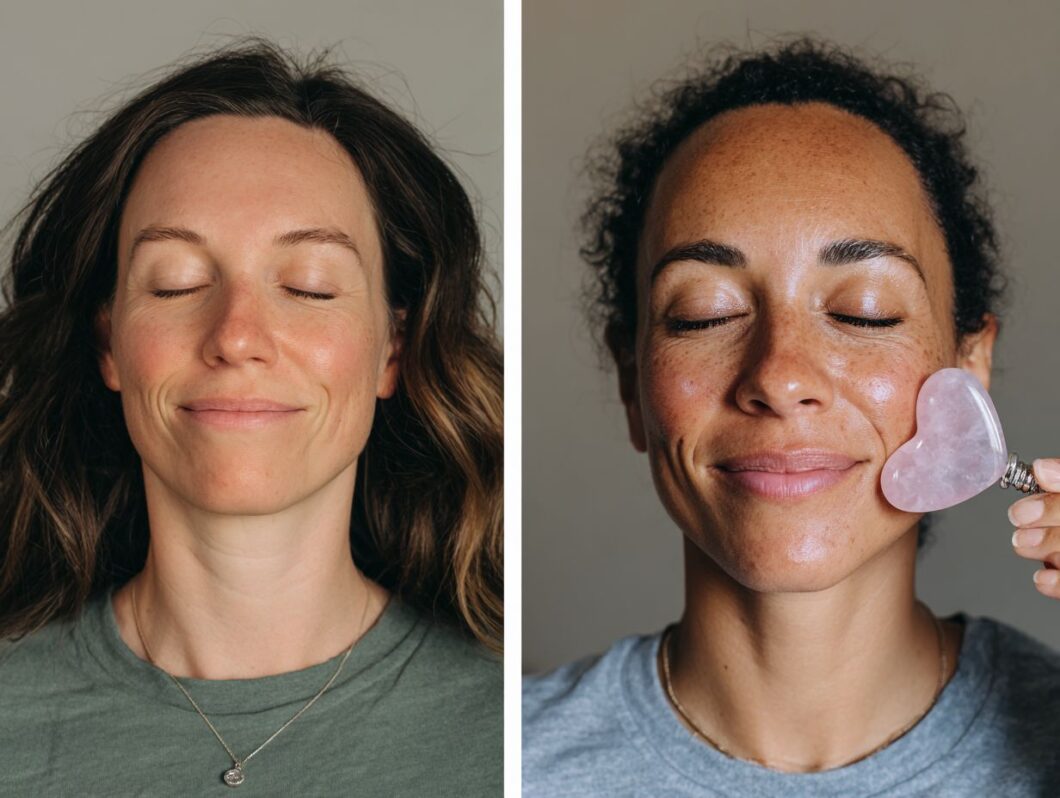As I navigated the world of beauty and wellness, two methods caught my eye: Face Yoga and Gua Sha. Both promise youthful skin and a radiant glow, but which truly delivers? With roots steeped in history, these practices offer unique techniques worth exploring. I’ll dive into their origins, benefits, and even the science behind them to help you decide which approach might be your secret weapon in achieving that coveted complexion. Join me on this enlightening journey!
Understanding Face Yoga and Facial Yoga Poses
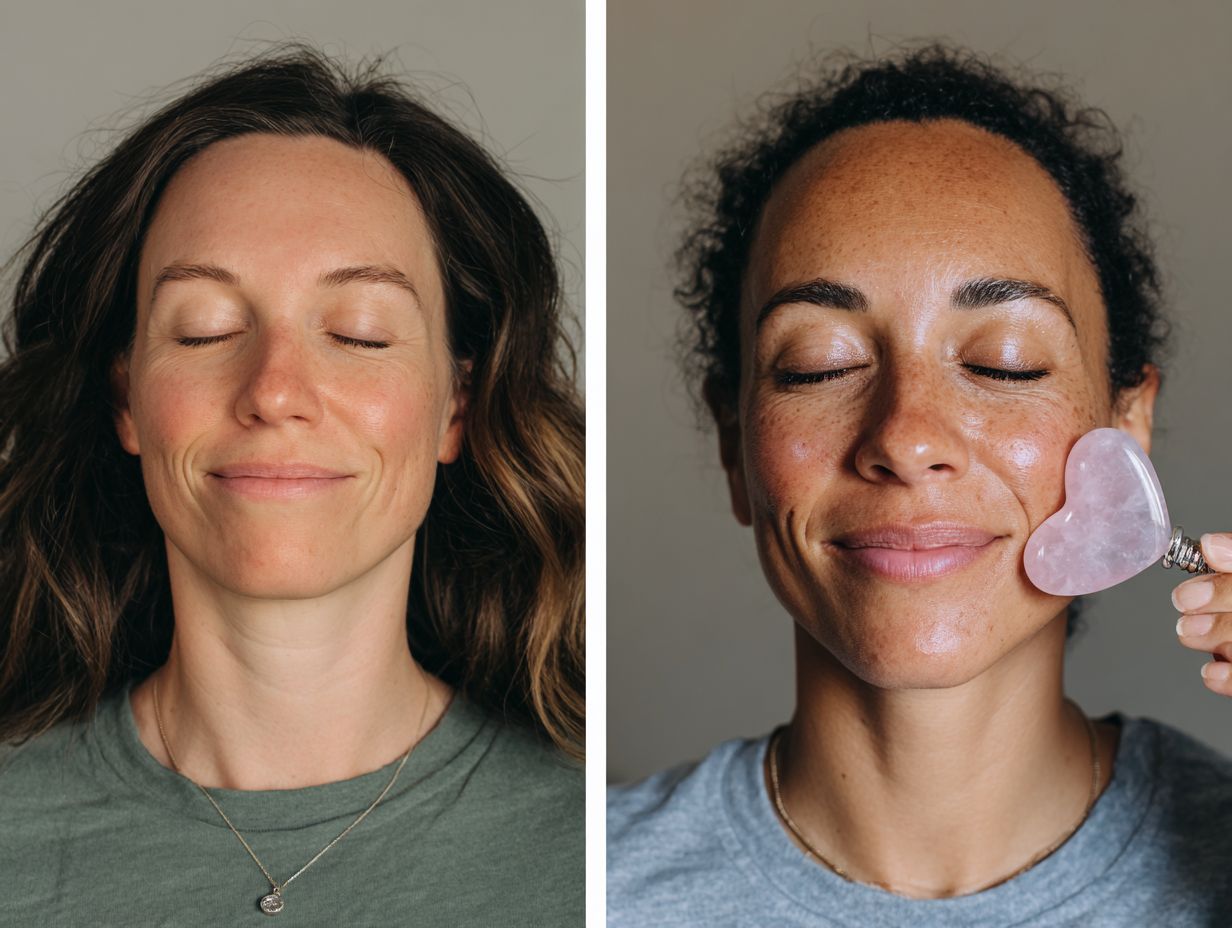
I utilize Face Yoga, which consists of a series of targeted facial exercises designed to enhance relaxation, skin lifting, and improve skin tone.
This approach has become a preferred solution for many individuals seeking effective non-invasive beauty treatments.
History and Origins of Holistic Skincare
Face Yoga has roots in ancient practices that are often connected to traditional Chinese medicine, focusing on wellness through facial movements and acupressure. I recognize the significance of facial exercises in improving muscle tone and enhancing circulation, key components of this timeless discipline.
Throughout the centuries, Face Yoga has evolved, integrating elements from Japanese and Indian rituals, which have ultimately shaped the beauty regimens we see today. As a practitioner, I employ specific techniques such as the ‘V’ movement to reduce wrinkles and ‘cheek lifts’ for added plumpness.
I often complement these exercises with tools like jade rollers and gua sha stones, which enhance the overall effects by stimulating blood flow and promoting lymphatic drainage.
These modern adaptations seamlessly connect holistic wellness principles with contemporary beauty standards, providing a comprehensive approach to self-care.
Techniques and Practices in Beauty Trends
Face Yoga encompasses a variety of techniques, including facial stretches and acupressure, which work together to enhance lymphatic drainage and stimulate collagen production.
Two particularly effective Face Yoga exercises I recommend are ‘The V’ and ‘The Smile Smoother.’
-
For ‘The V,’ I position my index and middle fingers to form a V shape at the inner corners of my eyebrows. I then gently press and glide outward toward my temples while maintaining consistent pressure, performing this for about 30 seconds to lift my brows and reduce frown lines.
-
For the ‘Smile Smoother,’ I place my fingers on my cheeks and adopt a broad smile while resisting the upward pull. I hold this position for 15 seconds.
I aim to practice these techniques daily to achieve optimal results in facial toning and skin elasticity.
Understanding Gua Sha and Therapeutic Massage
I utilize Gua Sha, an ancient healing method, which involves a smooth-edged tool for facial massage to promote skin revitalization and enhance facial contours.
History and Origins in Facial Therapy
Originating from traditional Chinese medicine, I have come to appreciate Gua Sha as a therapeutic method that has been practiced for centuries to enhance circulation, facial energy points, and energy flow.
Historically, Gua Sha was employed by practitioners to address various ailments, including muscle pain and tension. The technique involves scraping the skin with a smooth-edged tool, typically made from materials like jade or rose quartz.
In its traditional application, Gua Sha was focused on areas of discomfort or stiffness, promoting healing by mobilizing stagnant energy.
Over time, beauty applications emerged, utilizing lighter pressure and concentrating on the face to improve skin tone and reduce signs of aging.
Today, I observe how many adapt these ancient practices using modern tools such as silicone cups or electrically powered scrapers, effectively blending historical techniques with contemporary wellness trends.
Techniques and Tools for Natural Remedies
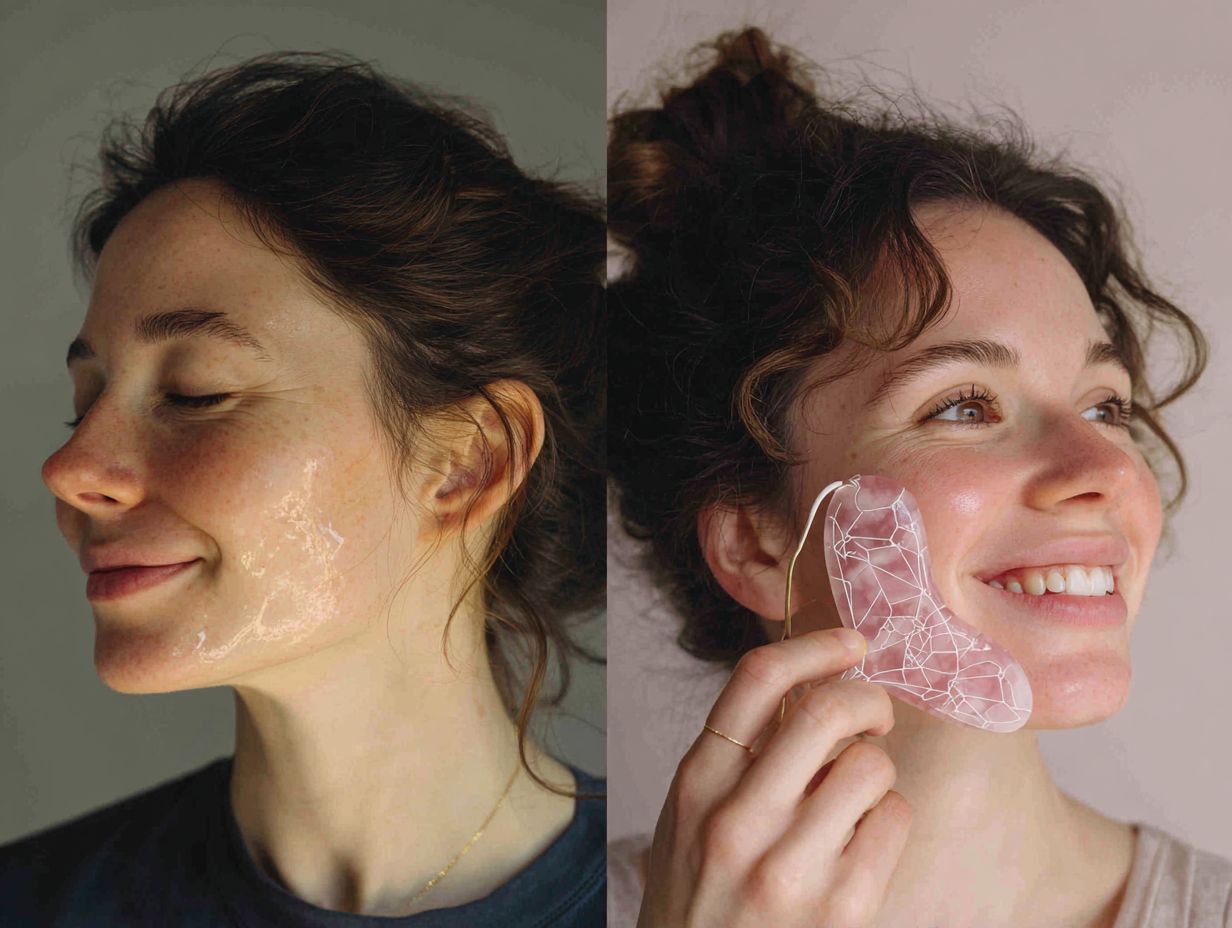
Practicing Gua Sha involves specific techniques and tools, including jade or rose quartz stones, which I use to glide over my skin to promote lymphatic drainage, facial contouring, and enhance overall skin health.
To perform a basic Gua Sha routine, I begin by cleansing my skin and applying a nourishing oil to ensure smooth gliding. I then take my chosen stone, holding it at a 15-degree angle, and gently scrape it along my jawline and cheeks in upward motions. I make sure to repeat each stroke 5-7 times on each section of my face.
After completing my session, I cleanse the stone and apply a soothing moisturizer to lock in hydration. By practicing this technique 2-3 times a week, I not only enhance circulation but also promote a radiant complexion.
Comparative Benefits and Beauty Effectiveness
I find that both Face Yoga and Gua Sha offer unique advantages for enhancing skin health, facial glow, and promoting relaxation.
However, they each focus on different aspects of beauty and wellness.
Skin Health and Appearance with Beauty Enhancement
I find that Face Yoga significantly promotes improved blood circulation and collagen production, while Gua Sha enhances lymphatic drainage-both of which contribute to a more youthful and radiant complexion.
Through regular practice of Face Yoga, I can increase skin elasticity, facial symmetry, and muscle tone by up to 30% within eight weeks, as the muscles become toned and firmness is restored.
By employing Gua Sha techniques, I stimulate blood flow, which helps in reducing puffiness and fine lines. For example, integrating a jade roller into my Gua Sha routine can further enhance these benefits by providing a thorough and gentle massage.
I recommend aiming for 10 to 15 minutes of combined techniques several times a week to observe significant improvements in skin texture and overall health.
Muscle Tone and Relaxation with Natural Skincare
While I recognize that Face Yoga primarily focuses on enhancing muscle tone through targeted exercises, I also appreciate the deep relaxation that Gua Sha provides through its massaging techniques, effectively reducing stress and tension.
My Face Yoga routines often include exercises such as the ‘V’ pose to strengthen the jawline and ‘The Squeeze’ for the cheek muscles. Dedicating just 10 minutes daily to these practices can significantly enhance muscle tone and improve facial contours.
On the other hand, I utilize tools like rose quartz or jade for Gua Sha, gently scraping along the skin to promote lymphatic drainage and relaxation. Many users, including myself, have reported feeling less stressed and noticing improved muscle definition after just a month of integrating both practices.
By combining these methods, I find that I can achieve comprehensive facial rejuvenation and maintain a balanced emotional state.
Scientific Evidence and Studies on Beauty Benefits
Recent studies provide compelling evidence supporting the efficacy of Face Yoga and Gua Sha in promoting skin health and enhancing aesthetic outcomes. Research published in the Journal of Clinical and Aesthetic Dermatology indicates that facial exercises can increase collagen production by 20% within 12 weeks, which leads to improved skin elasticity.
Additionally, a study featured in The Journal of Alternative and Complementary Medicine highlights Gua Sha’s role in enhancing microcirculation, resulting in a 15% increase in skin hydration. By incorporating a daily routine of Face Yoga alongside bi-weekly Gua Sha sessions, I can synergistically improve overall skin texture and firmness, providing a non-invasive alternative to traditional rejuvenation methods.
Practical Considerations for Skincare Modality
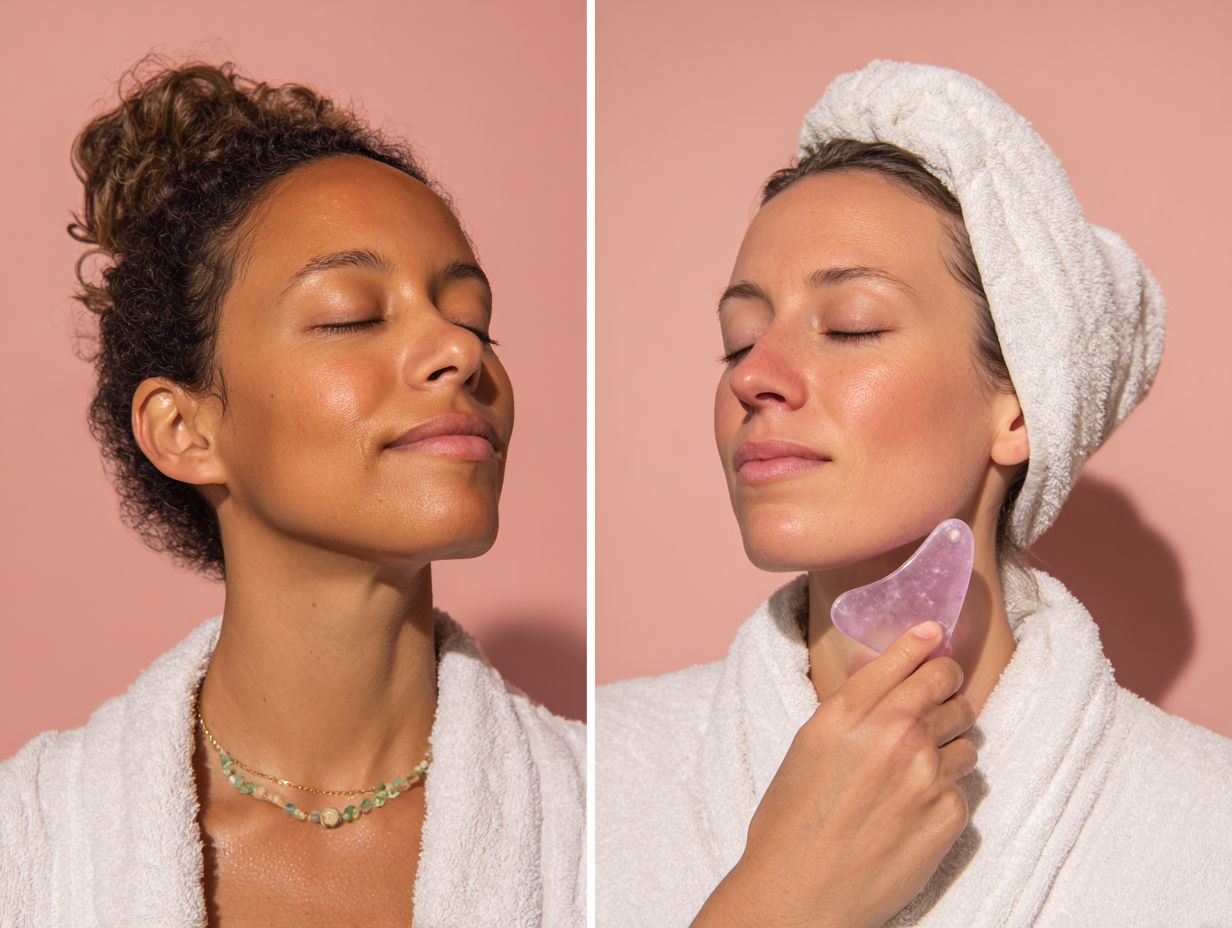
When evaluating the choice between Face Yoga and Gua Sha, I find that practical considerations such as time commitment and cost significantly impact my decision-making process.
Time Commitment and Ease of Use in Beauty Rituals
I typically commit to Face Yoga for 10-20 minutes each day, while Gua Sha sessions can be completed in as little as 5 minutes. This makes both practices accessible regardless of my schedule.
To effectively integrate these techniques into my beauty routine, I set aside a specific time each day. For beginners, I recommend performing Face Yoga every morning before starting my skincare regimen, as it promotes effective muscle relaxation. I find the ‘Face Yoga’ app particularly useful for guided routines that address various concerns.
For Gua Sha, incorporating it into my evening routine proves beneficial; I simply use the tool on my clean face with a light facial oil. Establishing consistency, even if it’s just 5 minutes for Gua Sha, can lead to visible improvements in my skin’s radiance.
Cost and Accessibility in Beauty Techniques
Face Yoga requires minimal investment in tools, often just a mirror, while Gua Sha tools typically range from $10 to $50, making both practices highly accessible. I find that both Face Yoga and Gua Sha offer effective methods for enhancing facial aesthetics without the need for costly salon treatments.
For instance, Face Yoga emphasizes specific exercises to tone facial muscles, and these can easily be learned through free online tutorials available on platforms like YouTube. On the other hand, Gua Sha involves scraping the skin with a smooth-edged tool, which can help improve circulation and reduce puffiness.
I can easily find affordable Gua Sha tools on sites like Amazon or at local beauty stores. Ultimately, both methods present a cost-effective way to achieve radiant skin from the comfort of home.
Frequently Asked Questions on Facial Rejuvenation
What is the difference between Face Yoga and Gua Sha?
Face Yoga is a facial exercise method that involves specific movements and poses to tone and relax facial muscles, while Gua Sha is a massage technique that uses a flat tool to gently scrape the skin and improve circulation.
Which one is more effective for anti-aging?
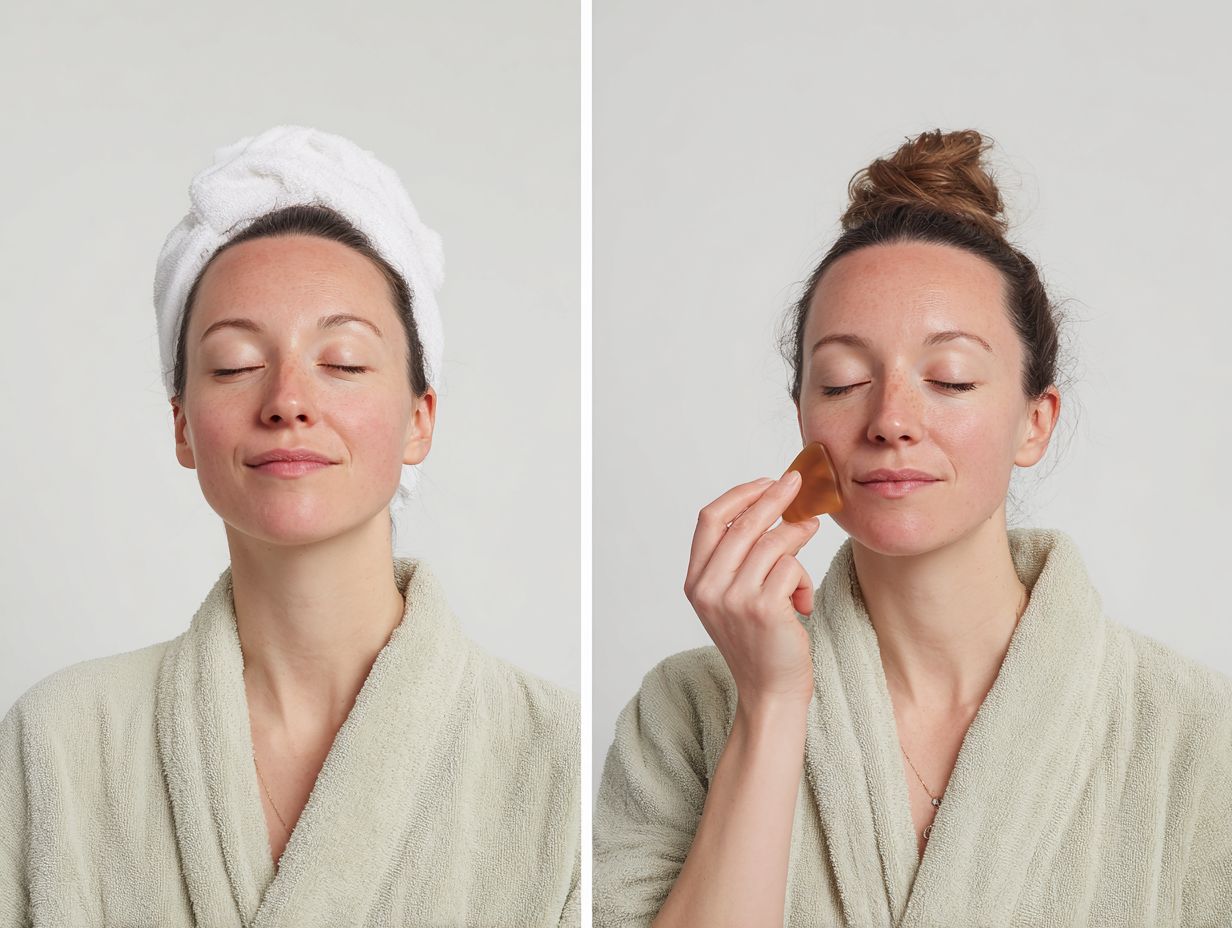
Both Face Yoga and Gua Sha can have anti-aging benefits. Face Yoga can help to strengthen facial muscles, while Gua Sha can improve blood flow and promote collagen production for smoother and firmer skin.
Is Face Yoga or Gua Sha better for reducing wrinkles and improving facial wellness?
It’s difficult to say which is better as both techniques can help to reduce the appearance of wrinkles. However, Gua Sha, a traditional practice in Chinese medicine, may have a more immediate effect due to the manipulation of the facial muscles and soft tissue for facial tension relief.
Can both Face Yoga and Gua Sha be done at the same time for holistic beauty and facial rejuvenation techniques?
Yes, Face Yoga and Gua Sha can be complementary practices in a skincare routine. Face Yoga can help to warm up and loosen the facial muscles before using Gua Sha, and Gua Sha can enhance the effects of Face Yoga by improving blood flow, aiding in lymphatic drainage, and puffiness reduction.
Is either Face Yoga or Gua Sha better for improving skin texture and facial definitions?
Both Face Yoga and Gua Sha can improve skin texture by promoting circulation and collagen production, key aspects of dermal health. However, Gua Sha may have a more direct impact by smoothing out any facial tension or tightness that can contribute to uneven skin texture, a beauty enhancement tool for skin vitality.
Are there any risks or potential side effects of practicing Face Yoga or using Gua Sha as non-invasive treatments?
Both Face Yoga and Gua Sha are generally safe skincare modalities that incorporate mindfulness and relaxation techniques, but as with any new skincare or exercise regimen, it’s always a good idea to consult with a medical professional or skincare specialist if you have any concerns or preexisting conditions. Overuse of Gua Sha or incorrect technique can cause bruising, and Face Yoga should include neck exercises and chin lifts and be done with proper form to avoid strain or discomfort.


